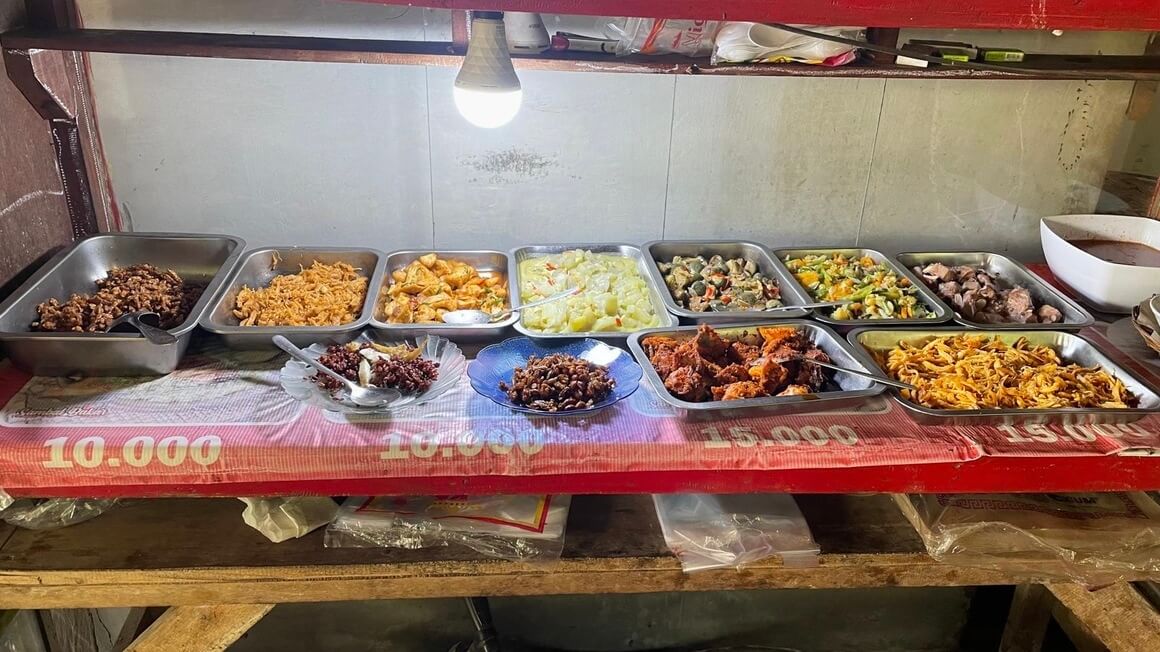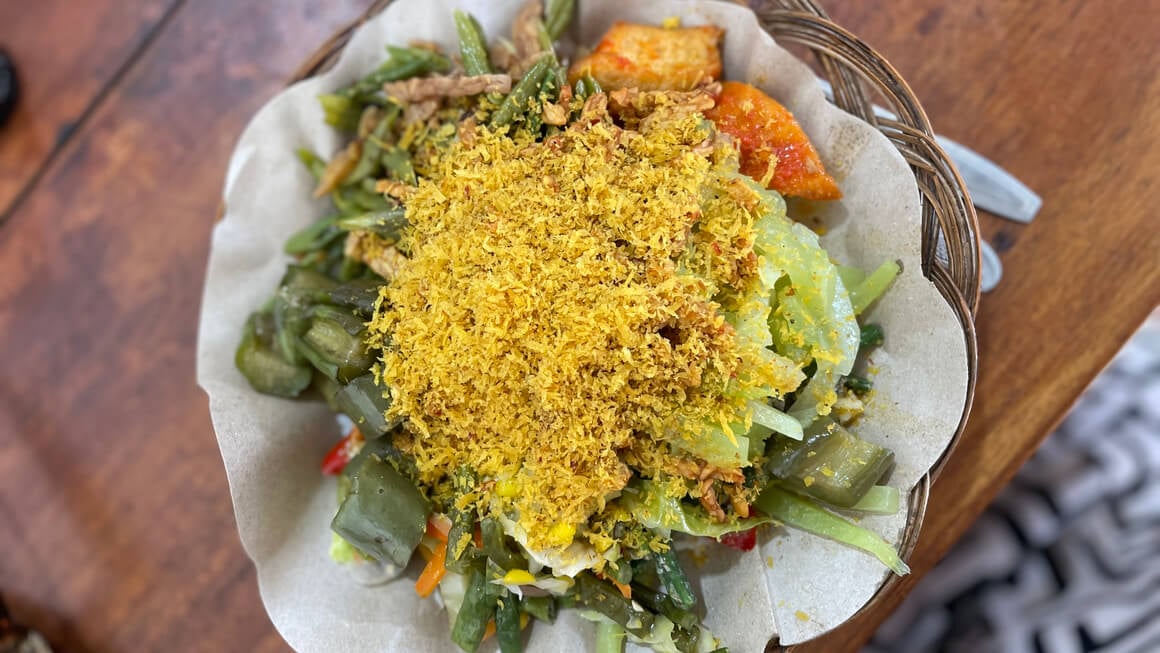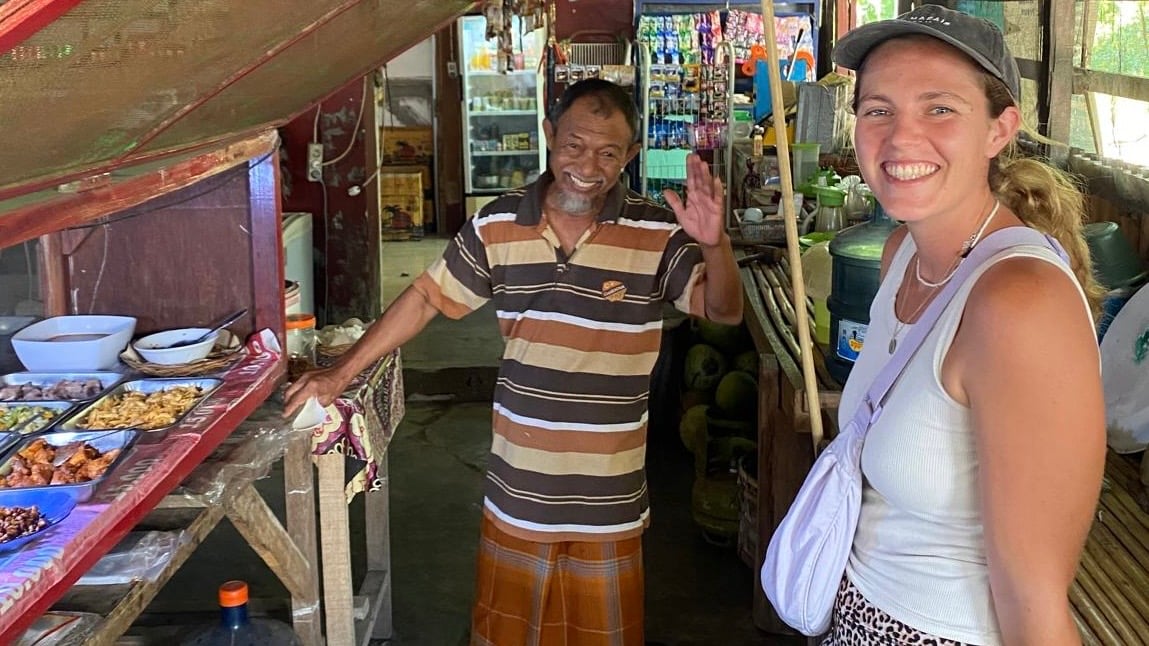Indonesia is a dream location for many travellers and is swiftly becoming a staple on the Southeast Asian backpacking trail. Anyone who has been to blissful Bali, bustling Jakarta or infact any other part of Indonesia will have seen warungs EVERYWHERE!
For those of you planning your trip to Indonesia, warungs are found on every street corner, every beach and on every mountain top. You can literally find a warung in Indonesia around every corner…
But what the hell are they? And why should you go to a warung?
Well friend, let me tell you that Indonesian food is severely underrated. Visiting a warung is the BEST way to seek out authentic experiences and indulge in all the classic Indonesian delicacies and flavours whilst supporting local businesses, people and communities!
Let’s find out what to expect from a warung and all the info you’ll need to start chomping away.

Photo: @joemiddlehurst
The Broke Backpacker is supported by you. Clicking through our links may earn us a small affiliate commission, and that's what allows us to keep producing free content 🙂 Learn more.
What is a Warung?
A warung sometimes spelt ‘waroeng’ is a small, family-owned shop, restaurant or cafe and they can be found all over Indonesia. Each Warung is incredibly unique and local families have often run them for generations. They’re kept running by hard-working people and are places to rest and refuel for locals and foreigners visiting Indonesia.
Unlike the standard restaurants found in the West (and most of Bali), Warungs belong to the people. They are incredibly inclusive places too, and you will find all sorts of folks sitting together on shared tables. People from all races, religions, socio-economic backgrounds and walks of life come together in these beautiful places to eat home-cooked Indonesian food with no judgment from one another.

Photo: Samantha Shea
A classic warung differs from modern warungs in many parts of Indonesia which have changed to appeal to the masses of tourists visiting Bali and other places. They are often hidden in odd locations, shabby looking, or simply in front rooms of family homes. To many Indonesians, a warung is still simply a small convenience store or place to buy coffee, tea, or food.
Modern warungs (the restaurant type) give Grandma’s cooking vibes… And you already know that Grandma’s cooking is always better than a Michelin star chef’s, all day long!
Two things that commercial restaurants simply cannot mirror are the authenticity combined with the secret ingredients of love and care put into each dish by the cooks at a warung. One of my biggest Bali travel tips for anyone planning a visit is always to hit them up.
Indonesian Food You Can Eat In a Warung
Many warungs are classic sitdown and order-from-menu-style restaurants, but others are more like pay-for-what-you-eat buffets. To let you in on a secret, these ones are always superior (if the food is still warm)
Nasi Campur is a somewhat flexible Indonesian dish centred around rice that comes with a variety of side dishes of proteins and vegetables. When you visit many warungs you can mimic the Nasi Campur style with whatever food (and as much protein) as you’d like.

The sit-down restaurants don’t need much explaining. Some of the most classic Indonesian dishes to be found on a classic warung menu include but are not limited to:
- Nasi Goreng (Fried Rice)
- Mie Goreng (Fried Noodles)
- Sate Ayam (Chicken Satay)
- Soto Ayam (Chicken Soup)
- Gado Gado (Mixed Veg in Peanut Sauce)
- Beef Rendang
- Bakso (Meatballs)
- Tempeh (Fermented Soybeans)
Indonesian food and warungs in general are very vegetarian-friendly. Foods such as Tempeh, Tofu, Eggs, Rice and Noodles are extremely common and meat is easily avoided.

Photo: @danielle_wyatt
That being said, the meat (and more specifically the chicken) is undoubtedly the highlight of every plate of food I’ve ever bought in a warung.
My personal favourite food to order from Warungs in Indonesia is Sate Ayam (chicken satay). This chicken in a subtly sweet, nutty and kind of spicy peanut sauce which is just divine. Though, I have also had the tempe version and that was also lit af!
Are Warungs Safe to Eat In?
Whilst most of Indonesia is safe, amongst the most common worries for those who visit this country are the food and water safety levels. Yes, some of these concerns are valid, but I can say from personal experience that I have eaten in hundreds of different warungs and NEVER had any negative experiences whatsoever.
It must be stated that many warungs can seem a little dodgy at times. For starters, many warungs lack any official permits to sell food and don’t perform hygiene checks.
There are then the glaringly obvious questions that your mind will ask you when you step into one of these fine establishments.
“How long has that been sat there?“
“What even is that?“
“That doesn’t look clean!“
With that all being said, I actually think it’s slightly disrespectful to assume a warung is unsafe to eat in because its different to what you’re used to. I know for a fact that most warungs are completely safe to eat in.

Photo: @danielle_wyatt
The simple way to decipher whether a particular establishment is safe (or good) to eat in is to see how many locals (or even tourists) are eating there. As a general rule of thumb, if others are fine, you will be too!
Now then, I’m sure you’ve heard of ‘Bali Belly‘, whether it’s from your new mate from your hostel in Canggu or your Aussie surf buddy in Uluwatu. There are hundreds of stories of people getting food poisoning from warungs in Bali, but I’ve never seen it myself.
Anyway, if you want to reduce your chances of getting ‘Bali Belly’ you should eat in busy restaurants and avoid tap water. Asking for no ice in drinks and buying drinks that are packaged and sealed (in bottles or cans) is the best way to do this.
Basically, just use your common sense.
Anyway, let me just say this, the only time I’ve ever had food poisoning in Southeast Asia was in a hotel restaurant on Cat Ba Island in Vietnam… shudders!
How Expensive Is Food in Warungs?
Depending on where you are in Indonesia, the price of a meal in a warung can vary greatly. Generally, there is a standard Indonesian price range and then theres the Bali price range, although these can overlap in places.
Some of the cheapest meals I’ve purchased in remote parts of Indonesia have cost me less than 5,000 IDR (0.30 USD)! But the standard price of a meal in a warung is more like 20,000 to 40,000 IDR (1.25 to 3.10 USD).

Photo: @joemiddlehurst
Of course, Bali is expensive, so if you visit a warung here, specifically in the ‘trendy’ parts like Uluwatu or Canggu, prices can soar. But generally, you won’t be paying more than 80,000 IDR or 4-5 USD for a meal – and a drink included in that estimate.
If you do what I do and load up on excessive amounts of protein at the buffet-style warungs, prices can creep up to around 60,000 to 80,000 IDR which is about 4 to 5 USD.
Why You Should Eat in Warungs
Why the hell would you not eat in a warung!?
Ok, I get that sometimes people want different things, occasional fine dining, or just miss home comforts and familiar foods. But really, there is no better food to be found in Indonesia than at warungs.
When I am staying in Bali or backpacking through more remote parts of Indonesia, I try to eat in warungs nine times out of ten. Many people, (myself included) travel to get out of their comfort zones, experience new things, learn about different cultures and broaden their horizons.
You won’t be doing that at a burger shack or pizza place!
Food in Warungs is cheaper, nicer tasting and more authentic than in other restaurants. In addition, buffet-style warungs are great when you are eating out in groups or with picky eaters as you can choose exactly what you want on your plate!
It’s not all about the food either.
The staff are so caring, the atmosphere is often very social and exciting and there is a rawness and realness that comes with eating in warungs that you won’t find at McDonalds, that’s for sure.
Although, Macca’s in Bradford at 3 am comes close for very different reasons, but that’s a story for another day!

Photo: @danielle_wyatt
Supporting local businesses and avoiding feeding capitalist greed should always be on your mind as a budget backpacker. Not only are warungs cheaper than standard restaurants, but they are far more authentic and offer the opportunity to rub shoulders with locals.
Don’t Forget Travel Insurance
If you are worried about getting ill, or anything else bad happening whilst you’re travelling, then get insured! Good travel insurance is the best way to protect yourself from things that you cannot control.
Month to month payments, no lock-in contracts, and no itineraries required: that’s the exact kind of insurance digital nomads and long-term traveller types need. Cover yo’ pretty little self while you live the DREAM!
SafetyWing is cheap, easy, and admin-free: just sign up lickety-split so you can get back to work! Click the button below to learn more about SafetyWing’s setup or read our insider review for the full tasty scoop.
Final Thoughts on Warungs
Now that you know all there is to know about warungs, it’s time to go check some out!
One of my favourite ways to find the best warungs in your area is to hop on Google Maps and look for some warungs in your area with the best reviews. You can also ask other locals or tourists in your hostel or local vicinity which warungs they recommend.
Some of the best warungs I’ve ever been in have been the shadiest looking, most hidden, and least promising establishments. Do not judge a book by its cover and chase authentic experiences whilst in Indonesia. I promise you won’t regret it.
Enjoy your eating in Indonesia, folks. Until next time.
Oh, and don’t drink too many Bintangs!

Photo: @joemiddlehurst
Buy Us a Coffee!
A couple of you lovely readers suggested we set up a tip jar for direct support as an alternative to booking through our links. So we created one!
You can now buy The Broke Backpacker a coffee. If you like and use our content to plan your trips, it’s a much appreciated way to show appreciation 🙂







